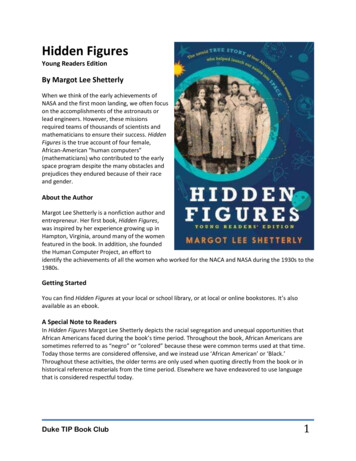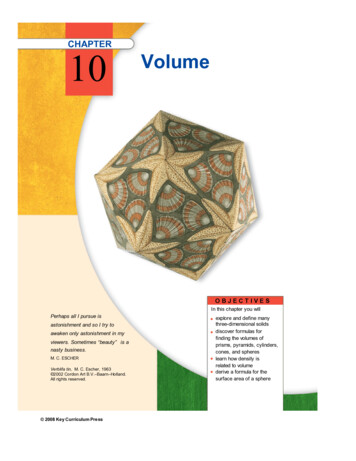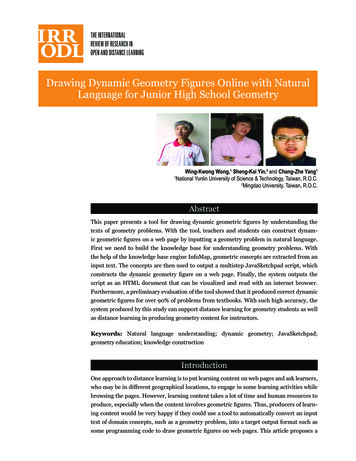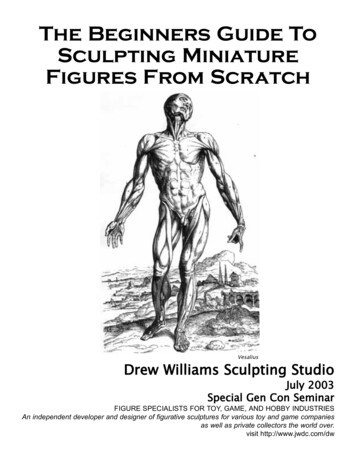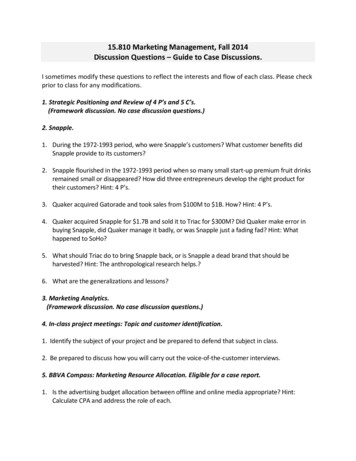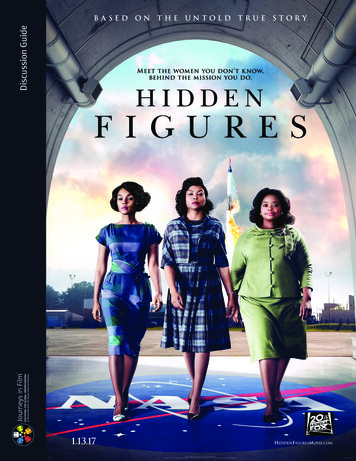
Transcription
Discussion Guide
The Numbers Don’t LieThe story of the black women who became “human computers,”in the total population and its representation in computingmathematicians, and engineers for NASA is the true storyjobs? How many possible explanations can you think of? Arebehind the film Hidden Figures. More than 50 years ago, theythese numbers the result of personal choices, discriminationconfronted employers who hired them only reluctantly. Theyin hiring, diverse educational experiences, or something else?worked in a southern state that was determined to opposeHow much change has there really been in the past 50 years?federal civil rights laws and to hold on to segregation, and inan age when women were generally encouraged to becomehousewives, nurses, teachers, or secretaries.As you think about careers today, think about the educationyou are engaged in right now. As a student, have you beenencouraged to pursue courses in science, technology,How they persisted, how they achieved their goals in spitemathematics, and engineering? How many such courses areof the many obstacles in their paths, how they convincedoffered at your school? Are there after-school activities youothers who doubted them of their value as employees andcan join that will increase your ability to use computers andeven leaders—these are the lessons of Hidden Figures thatsolve problems? Do you have some role models or mentorsare important for all students to learn today. Together,who can help you learn about these subjects?these women were able to accomplish more than they evercould have as individuals; they strengthened each other’sdetermination, encouraged each other in dark times, andworked to assure the success of their whole team.And what about the future? What will job prospects be likefor you as you graduate? Will you find a career that not onlysupports you financially, but that you can feel passionateabout? One in which you can take pride? Now is the time toBut that was half a century ago—ancient history. Aren’tstart planning that future. As you consider your own goals,things different today?think about your own strengths and the determination youLet’s start to answer this question by looking at the statistics for2012 from the United States Department of Labor (below):Why is there such a difference between each group’s sizehave to overcome any obstacles you might face, and thenplan a path that will really help you achieve, just as Katherine,Dorothy, and Mary did.Women hold 57% of professional jobs in the U.S., but just 26% of technology jobs and 19% of software developmentpositions. Women hold just 5% of leadership positions in technology.Black and Hispanic people make up 30% of the U.S. population (12% black and 18% Hispanic).Black and Hispanic men hold 9% of U.S. computing jobs. (Black men hold 4% of these jobs and Hispanic men hold 5%.)Black and Hispanic women hold 4% of U.S. computing jobs. (Black women hold 3% and Hispanic women hold 1%.)2Journeys in Film: Hidden Figures
Introduction to Hidden FiguresAs NASA begins preparations for the first landing of humanson Mars in the 2030s, the excitement and challenge of the earlyyears of manned space exploration will once again capturethe world’s imagination. What better time to re-examine theearly years of the space race and, in particular, the efforts ofthe people whose work behind the scenes made those firstepic voyages possible?In Hampton, Virginia, in 1961, segregation still ruled, in spite ofcourt orders and civil rights protesters. Workplaces, and especiallyworkplaces in the sciences, were dominated by men. But atLangley Research Center, a remarkable group of women, theso-called “human computers,” were solving equations, calculatingorbits, and laying the groundwork for the first successful flights bythe team of astronauts known as the Mercury 7.Katherine Johnson (played in the film by Taraji P. Henson),Mary Jackson (played by Janelle Monáe) and DorothyMary Jackson also began in the computer pool, and becameVaughan (played by Octavia Spencer) were among thoseNASA’s first black female engineer in 1958, after persuading awomen. As a girl growing up in West Virginia, Johnson hadjudge to allow her to take training courses at an all-white highbeen passionate about mathematics; pulled from the computerschool. She worked for many years writing and co-writingpool at Langley, she became part of the team that calculatedengineering studies; she then began a second career at NASA,the trajectories for Alan Shepard and John Glenn. Eventuallybecoming Langley’s Federal Women’s Program Manager inshe worked on the team that accomplished the moon landingorder to boost the careers of other women in science, math,in 1969. In 2015 she was awarded the Presidential Medal ofand engineering.Freedom for her 33 years of work at NASA.Their stories are told in the film Hidden Figures, based onDorothy Vaughn, a graduate of Wilberforce University,the book of the same title by Margot Lee Shetterly. Thisspent 28 years at NASA. First hired as a “human computer”discussion guide covers the film itself, background context toto make up for the shortage of manpower during Worldhelp you understand the society in which these women madeWar II, she used her mathematics skills to improve the speedsuch strides, and a look to the future of women in STEMand power of U.S. military aircraft. When computers were(Science, Technology, Engineering, and Mathematics) fields.introduced, she learned FORTRAN and became a pioneerThis film helps to ensure that these brilliant and hardworkingin computer programming.women will no longer be “hidden figures.”Journeys in Film: Hidden Figures3
Exploring the Film: Hidden Figures1. At the beginning of the film, Katherine appears in aflashback at school; she is several years younger than herclassmates and is asked to demonstrate the answer to amath question at the chalkboard. What does this scene say about her early ability andcharacter? How did her parents and teachers support hercontinuing education? Why did her family have to move for her to go to highschool? When does this image of a chalkboard reappear in thefilm? Why does the filmmaker choose to repeat it?Paul Stafford (played by Jim Parsons)? By Karl Zielinski(played by Olek Krupa), the self-identified “Polish Jew”?3. A major change at NASA occurs when the space agencypurchases an IBM computer. How does this computer compare with a typicalcomputer today? What difficulties do the engineers have installing thecomputer and making it operational? Why do thedifficulties arise? How does Dorothy learn enough to be able to operatethe computer? Compare Dorothy’s attitude toward her subordinates2. When Katherine first appears in her new workroom afterwith that of Mrs. Vivian Mitchell (played by Kirstenleaving West Computing, she is mistaken for the custodian.Dunst). How does Dorothy help her colleaguesWhat information does this brief but significant incidentsucceed after the IBM computer is installed?convey? How is she treated by her male co-workers? By4Journeys in Film: Hidden Figures
Do Dorothy’s attitude and actions have any implications6. The way that people address one another says a greatfor today’s workforce in an era of ever-increasingdeal about relative position. In most areas of the Southtechnological sophistication?during the period before the Civil War, slaves had no last4. The Mercury 7 astronauts came to Langley for training. What kind of reception did they receive? DescribeJohn Glenn’s first interaction with the women of WestComputing. What is the filmmaker trying to show inthis scene? Why does Glenn want Katherine to check themathematics behind his planned launch?5. Symbols are often used to make significant points in a film.How do the following repeated symbols help to tell thestory? Coffee: The placement of an extra coffee pot in Katherine’swork area Katherine’s reaction to the coffee pot Stafford’s offering her a cup of coffee at the end ofthe film The restroom The existence of a “colored” restroom in anotherbuilding a half mile away Katherine’s need to run the distance removal of the sign by Al Harrison(played by Kevin Costner) The pearls The dress code for women at NASA Katherine’s outburst when she says she can’t affordpearls The gift of a pearl necklace from Katherine’s coworkersnames. Even after 1865, when freedmen chose last namesfor themselves, whites generally called them only by firstnames. Richard Wright, in his memoir, Black Boy, wroteof how important it was to black adults to be called by“Mr.” or “Mrs.” and the last name. How do Stafford, Mitchell, and Harrison regularlyaddress the women of West Computing in the film?What does this say about the working relationship ofthese supervisors and these workers? What is the significance of Mrs. Mitchell addressingDorothy as “Mrs. Vaughan” at the end of the film?7. Katherine is regularly excluded from key meetings becausethere is no protocol for a woman to attend. Why is it important for her to attend? How does she prove to the men in the room that it isto their advantage for her to be present? Why does Harrison invite her into the room wheremen are tracking John Glenn’s flight and makingdecisions about what should be done to bring himback safely?8. In the climactic scene when John Glenn is about tore-enter Earth’s atmosphere, how does the filmmakercreate suspense?9. Mary Jackson, Dorothy Vaughan, and KatherineJohnson certainly deserve recognition as major figuresin the history of space science. Do their stories still carrymeaning for today’s young women? Can they help today’syoung women as exemplars and role models? What canthey teach us now?Journeys in Film: Hidden Figures5
The Jim Crow SouthRight after the Civil War, freed slaves and other U.S. residents1. Consider the scene early in the film when Dorothy is tryingof African ancestry hoped that they would have full rightsto restart the stalled car and a police officer drives up.as citizens. But after Union troops in the South withdrew,southern state governments passed laws that restricted therights of black people. The laws were called “Jim Crow” lawsafter a character in a minstrel show, and they lasted from 1877to the mid-1960s. They made it very difficult for black peopleto vote; they also made it illegal for them to use the samerestaurants, hotels, restrooms, and even water fountains aswhites. [This set of laws is an example of de jure segregation,separation of the races by law. There was also de factosegregation, separation by facts, such as where people settled;this type of segregation was common in the North as well.] What is the women’s reaction to the arrival of theofficer? Why? Why does he initially doubt their identities—becauseof their race or their gender? Why does he eventually give them an escort toLangley? Why does this scene have particular resonance today?2. When one of the engineers suggests that Mary might wantto be certified as an engineer, she learns that she must takenight courses held at the white high school in order to do so. The Supreme Court case of Brown v. Board of EducationIn 1896, in the case of Plessy v. Ferguson, the Supreme Courthad declared that separate but unequal school facilitiesheard arguments about laws segregating people of differentwere inherently unequal. Why does Mary still have toraces in railroad cars; the Court declared that laws requiringgo to court to be admitted to her classes?“separate but equal” facilities were constitutional. This rulingwas not overturned until more than half a century later,when the decision in Brown v. Board of Education outlawedde jure segregation in schools and paved the way for other How does she present her case to the judge? Why doeshe decide in her favor? How do her classmates and teacher react to herentrance?types of desegregation.6Journeys in Film: Hidden Figures
‘Eyes on the Prize’:The Civil Rights Movement in the ’50s and ’60sRosa Parks’s refusal to yield her seat on a bus to a whitepassenger in 1955 is often seen as the start of the modern civilrights movement. The year-long bus boycott that followedshowed the power of nonviolent protest and brought theReverend Martin Luther King, Jr., to national attention.Marches and protests throughout the South followed overthe next decade. In Greensboro, North Carolina, four blackstudents sat at a Woolworth’s lunch counter to protestsegregation and were soon arrested, but were followed bydozens who took their place, and eventually hundreds ofstudent protesters joined the movement. Black and white“Freedom Riders” rode together on buses along southernhighways. Voter registration drives and “Freedom Summer”teach-ins continued.After a decade of civil disobedience in the name of basic civilrights, Congress passed and President Lyndon B. Johnsonsigned the Civil Rights Act of 1964 and the Voting RightsAct of 1965. The first outlawed discrimination based on race,2. Dorothy stole a FORTRAN manual from the public library.color, religion, sex, or national origin. The second protecteda. Why did she do this? Was it necessary?the right of all adult citizens to vote; although guaranteed byb. How did she explain this decision to herself and to herthe 15th Amendment, the rights of black people in the Southhad been denied by poll taxes, discriminatory literacy tests,and outright intimidation and violence. These laws did notend all forms of discrimination, but the federal governmentwas now clearly committed to the enforcement of civil rights.1. How do the protests and marches of civil rights activistschildren?c. Was this an act of resistance or was it simple theft?3. How do the women of color at Langley fight for theirrightful place? How successful are they? How does theirexperience compare with the methods and achievementsof others in the civil rights movement?occurring elsewhere in the South, and the correspondingsegregationist response, influence the lives of the womenat Langley and their families?Journeys in Film: Hidden Figures7
A Woman’s Place.Women in the United States had historically lagged behind1. Many women who worked in West Computing had startedmen in economic and political power. While the 15thout as teachers in segregated schools; working for NASAAmendment stated that a state or the federal governmentgave them a big pay raise in spite of the fact that they werecould not deny the right to vote to any citizen because ofpaid less than the white women working there.“race, color, or previous condition of servitude, ” it saidnothing about denying the vote based on gender. Only in How did their backgrounds as teachers help them intheir work?1920 was universal women’s suffrage brought about by the Why was the extra pay important to these women?19th Amendment. Women’s right to vote, important as it What obstacles did they encounter on a daily basiswas, was not reflected in political office-holding, however. In2016, women held less than 20 percent of Congressional seatsand no woman had ever been elected president.1simply because of their gender?2. After the labor shortage of World War II, many womenwho had worked in war industries returned to domesticThe economic power of women also suffered in comparisonlife, as men returned from overseas. That assignment ofwith men. In Hidden Figures, NASA was ahead of other partswomen to the domestic sphere was still considered idealof government or business in seeking out talented women.in the 1950s. Instead of returning to family life like manyIn other parts of the business world, women’s traditionalothers, the “human computers” of NASA continued tooccupations were often limited to secretary, teacher, or nurse.work long hours at Langley in addition to caring for theirMedical and law schools, as well as other graduate schools,families.were often reluctant to admit women. Pay for women was(and still is, in many cases) less than that of men for the same How does working at NASA affect Katherine’s familylife?job; the pay gap for women of color is even larger than the How well do her children seem to adjust?average.2 What support does she have in raising her family? Why does Levi Jackson (played by Aldis Hodge) opposeMary’s efforts to take classes to become an about-the-gender-pay-gap/8Journeys in Film: Hidden Figures
The Women of West ComputingMany women were recruited to work as “human computers,” first at NACA (the National Advisory Committee for Aeronautics)and then at NASA (the National Aeronautics and Space Administration). The film Hidden Figures highlights three of themost prominent black women, whose brilliance in mathematics helped to propel John Glenn into orbit. Because of their race,however, they were placed in a special unit called West Computing, and located at a distance from the other women who weredoing the same type of work.Read the biographies of each of these remarkable women at the NASA website:Katherine JohnsonMary JacksonDorothy Vaughan (left) with other puters Leslie Hunter (middle) ivian t/dorothyvaughan-biography1. Although the film starts in 1961, the history of women3. What was the attitude of Mrs. Mitchell to the women ofwho worked as “human computers” at Langley goes backWest Computing in general and to Dorothy Vaughanto the days of World War II. A severe shortage of skilledin particular? How did Mrs. Mitchell demonstrate thismathematicians led to the hiring of women to supplementattitude? Did it eventually change? If so, how—and why?the male engineering force working on improving militaryaircraft. Do you know of any other instances when anational emergency has led to increased opportunities forwomen?2. Why were the black computer experts segregated from the4. Mr. Stafford, the engineer, repeatedly has Mary Jacksonremove her name from reports and tells her “Computersdon’t author reports.” Why was he unwilling to let hershare the byline? Should her name have been on thereports? Why, or why not?white specialists?Journeys in Film: Hidden Figures9
The Cold War and the Space RaceLangley Field, near Hampton, Virginia, was founded in1. The Soviets, having achieved the atomic bomb in 1949 and1917, during World War I, as part of the United States warthe more powerful hydrogen bomb in 1955, now turnedeffort, when airplanes were just coming into use as weaponsto space.of war. During World War II, Langley’s wind tunnels and What achievements by the Soviets led to increasedengineering facilities helped to make American aircraft aurgency in the United States space program?pre-eminent factor in winning that war. Were Americans being paranoid or did they have alegitimate reason for fearing Soviet accomplishments?By the late 1940s the United States and its wartime ally the How does Harrison respond to the increased pressure?Soviet Union had become enemies again, competing forAre the demands he places on his team reasonable?prestige and for influence over the rest of the world. By 1949How do they respond?the Soviet nuclear development program had been successfulin building their own atomic bomb, and within a few years2. John Glenn was not the first American into space. He wasboth nations had developed even more powerful hydrogenpreceded by Alan Shepard and Virgil “Gus” Grissom.bombs. The “arms race” to stockpile ever more dangerous Why was John Glenn’s flight so important to theweapons was on. When the Russians launched the firstAmerican public?satellite to orbit the Earth in 1957, U.S. citizens were shocked There were no black astronauts among the Mercuryand horrified. Fear that the Soviets could launch an attack7. The first black astronaut was Guion “Guy” Bluford,from space led to a massive campaign to catch up, and thewho was aboard the Challenger space shuttle in 1983.National Aeronautics and Space Administration (NASA)The first American female astronaut, Sally Ride,3was organized. Many engineers and mathematicians fromflew in the same year, a full 20 years after her SovietLangley became part of this effort.counterpart. Why did it take so long for the ranks ofastronauts to open to black and female candidates?3. How did the fact that television news coverage was liveinfluence the public’s response to Glenn’s flight? How didit complicate the work of NASA?4. Read about John Kennedy’s call for Americans to go tothe moon at http://history.nasa.gov/moondec.html .(You can also listen to his speech at this site.) How didKennedy’s goal inspire Americans and affect the lives ofNASA workers?3 Janelle Monáe, who plays Mary Jackson in Hidden Figures, released the song “Sally Ride” in 2013.10Journeys in Film: Hidden Figures
Looking at the Future: Career Choices in Science,Technology, Engineering, and Math (STEM)1. Who are the women of NASA today? Read about someof the women currently working for NASA at https://women.nasa.gov/ . How did they become interestedin working for the space agency? What education andexperience did they need to qualify for their jobs? Werethe requirements any different from those men had tomeet?2. What kinds of exploration and research is NASA workingon right now? Would you be interested in working forNASA? Why, or why not?3. On a webpage about Katherine Johnson in STEM time-of-stem.html), NASA suggests some lessons to learn from her life: Love learning. Follow your passion. Accept the help you’re given, and help others whenyou can.4. Besides aerospace science, what other kinds of STEMcareers might you be interested in? What kind of Follow new leads and don’t give up. Keep trying.education do they require? Are you on the path to earn Go beyond the task at hand; ask questions; bethe requisite degree(s) for your career path?inquisitive. Let yourself be heard. Do what you love, and love what you do. You are as good as anyone in this town, but you are nobetter than any of them.What are three ways that you could apply these lessons toyour own life right now?5. As the story of the women in Hidden Figures makes clear,having a mentor in one’s career can be helpful. What are the qualities you would like to have in agood mentor? Who has been a mentor for you in your educationaland career path so far? How did he or she help you? Are you mentoring anyone younger or lessexperienced than you now? If so, what can you passalong that would be helpful to that person?Journeys in Film: Hidden Figures11
Additional Reading and ResourcesPrintShetterly, Margot Lee. Hidden Figures: The American Dream and the Untold Story of the Black Women Mathematicians WhoHelped Win the Space Race. New York: William Morrow, 2016.Sobel, Dava. The Glass Universe: How the Ladies of the Harvard Observatory Took the Measure of the Stars. New York: Viking,2016.Holt, Nathalia. Rise of the Rocket Girls: The Women Who Propelled Us, From Missiles to the Moon to Mars. New York: Little,Brown and Co., 2016.OnlineWei-Haas, Maya. “The Forgotten Black Women Mathematicians Who Helped Send Astronauts to rs-and-sendastronauts-space-180960393/Official site of Women@NASAhttps://women.nasa.gov/NASA’s website on John Glennhttps://www.nasa.gov/johnglennA history of early omputers/The U.S. Department of Education website for STEM (Science, Technology, Engineering, and Mathematics) educationhttp://www.ed.gov/stemThe White House report on ostp/womenRecent statistics about women in STEMhttps://ngcproject.org/statistics12Journeys in Film: Hidden Figures
Film creditsDirector: Theodore MelfiScreenplay: Allison Schroeder and Theodore Melfi, based on the book by Margot Lee ShetterlyProducers: Donna Gigliotti, Peter Chernin, Jenno Topping, Pharrell Williams, Theodore MelfiActors: Taraji P. Henson, Octavia Spencer, Janelle Monáe, Kirsten Dunst, Jim Parsons, Mahershala Ali, Aldis Hodge, Glen Powell,Kimberly Quinn, Kevin Costner, Olek KrupaImage creditsP. 9: NASAAll other photos courtesy of 20th Century FoxThis discussion guide for the film Hidden Figures was written by Eileen Mattingly, Director of Education at Journeys in Film.For additional free materials to bring the world to your classroom, see http://journeysinfilm.org.Journeys in Film: Hidden Figures13
Educating for Global UnderstandingIn Partnership with USC Rossier School of EducationJourneys in Film50 Sandia LanePlacitas, NM 87043505.867.4666www.journeysinfilm.org www.journeysinfilm.org
Mar 01, 2017 · discussion guide covers the film itself, background context to help you understand the society in which these women made such strides, and a look to the future of women in STEM (Science, Technology, Engineering, and Mathematics) fields. This film helps to ensure that these brilliant

